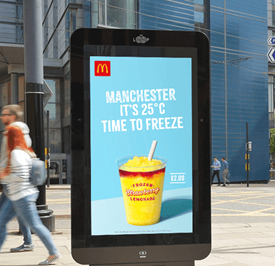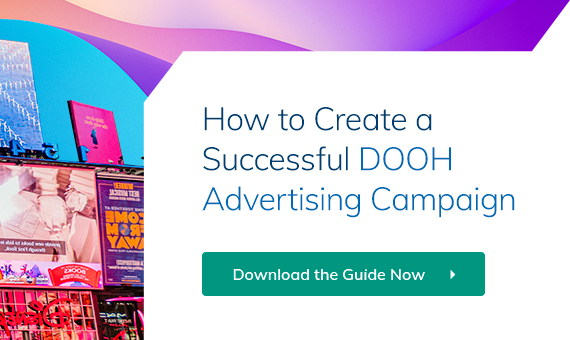Real-Time or redundant? Why agencies that can’t prove DOOH ROI are getting left behind
If you’re pitching Digital Out-of-Home (DOOH) to clients and relying on outdated media metrics, you’re not just behind, you’re bleeding opportunity.
In a world of real-time analytics, agencies that can’t prove campaign performance lose to those who can. And DOOH is no longer a “trust me, it’s good for brand” play. With the right platform, it becomes a live performance channel, measurable, optimizable and ROI-validated.
But here’s the problem. Most clients still think of DOOH as digital wallpaper. Static, untrackable and only suitable for brand awareness.
That disconnect is killing deals and leaving media budgets on the table.
If you want to win bigger clients and justify larger investments, you must bridge the gap between perception and performance.
Why agencies struggle to sell DOOH (And how real-time solves it)
Most agencies lose the battle before the campaign even starts. Why?
Because clients ask, “How do I know it worked?” And too often, your team doesn’t have a compelling answer. They talk about impressions, footfall estimates, or vague “lift.” But none of it connects to the client’s bottom line with either confidence or clarity.
Real-time insights change that
When you can show performance as it happens across screens, cities and triggers, you eliminate doubt and turn every campaign into a story clients can see, understand and most importantly from your agency’s viewpoint, buy into again.
What makes modern DOOH a performance channel?
Let’s be clear. This is not traditional OOH with a digital veneer. Real-time DOOH, when done right, competes head-to-head with full-scale digital media.
Why?
1. Dynamic creative at scale
Content adapts live to weather, time of day, location, or audience triggers. Campaigns that use dynamic creative see up to 40% more engagement, especially when matched with contextual data like weather or time-based prompts.
2. Programmatic activation
You can buy, pause and adjust media in reaction to campaign performance, down to the minute, the screen, or the zip code.
3. Real-world reach. Digital precision
DOOH doesn’t just show up on a screen, it reaches people where they work, commute, shop and socialize. With mobile data integrations, you can tie that exposure to behaviour across devices.
Strategic Use Case:
For agencies running omnichannel campaigns, DOOH becomes the connective tissue between brand storytelling and performance.
- Launching a product? Pair DOOH with mobile retargeting.
- Running a promotion? Trigger creatives during peak footfall hours.
Real-time DOOH isn’t a silo, it’s a multiplier for the entire media mix.

Image source: Grand Visual
4 ways real-time insights prove DOOH campaign ROI
1. Track impressions and reach like a digital channel
Modern DOOH platforms use mobile location data, sensor technology and AI modelling to estimate audience exposure with a high degree of accuracy.
These technologies work in tandem to anonymously detect and analyse audience presence near screens, providing accurate estimates of who saw the ad without compromising privacy. This allows you to:
- See impressions per screen, per time block.
- Break down data by location, age group, gender, or behavior.
- Compare reach across cities or creatives. 75% of advertisers say measurability has significantly improved their perception of DOOH
2. Attribute results to online and offline actions
The holy grail of any campaign is attribution – proving that an ad directly influenced customer behavior.
With DOOH, this is now possible through cross-channel integrations and mobile ID tracking:
- Footfall attribution. Show how DOOH ads increased visits to physical stores.
- Website uplift. Measure how DOOH exposure correlates with traffic spikes.
- QR code engagement. Use interactive DOOH to drive trackable clicks or downloads.
Case in point
A retail chain used DOOH to target commuters in five cities during morning rush hour. They tracked a 22% increase in in-store foot traffic and a 13% uplift in mobile website visits within 48 hours of exposure.
The campaign’s QR engagement also spiked 29%, validating both offline and digital influence, all attributed to contextual targeting and real-time data syncing.
3. Optimize campaigns mid-flight
Instead of waiting until the campaign ends, you can adjust in real time:
- Swap underperforming creatives.
- Increase exposure in high-performing regions.
- React to real-world conditions (e.g., rain, sports scores, traffic congestion). It has been shown that contextually triggered content increased brain response by 32% compared to generic ads.
4. Make clients look good with custom dashboards
Real-time dashboards help you:
- Present live campaign results with easy-to-read charts.
- Segment by market, creative, or device.
- Share branded client-facing portals that build trust. This data empowers clients to make more informed decisions for future campaigns, ensuring their marketing budgets are optimized for maximum impact.
How to address common client misconceptions
Most client resistance comes from a lack of understanding. Here’s how to reframe the conversation using real-time insights:
|
Client Concern |
Real-time Reframe |
|
DOOH is just digital billboards |
We dynamically target audiences based on location, weather and behaviour. |
|
I can’t measure who saw it |
Here’s a heatmap of impressions by time and demographic. All privacy safe. All real. |
|
It’s too broad, not targeted |
We activated only in postcodes with high footfall from your exact audience segments. |
|
How do I know it worked? |
Your store visits increased 18% in the 24 hours after exposure. Here’s your dashboard. |
The Neuron. Your agency’s DOOH advantage
If we’re cutting the fluff, it’s true to say that most DOOH platforms aren’t built for performance marketers. The Neuron is.
It gives you:
- Live Campaign Dashboards. Visualize impressions, spend, dwell time and attribution in one place.
- Triggering Engine. Launch time, weather, or audience-based campaigns that adapt live with no manual updates required. The triggering engine doesn’t just save time, it lets your team act on audience behavior instantly, turning every screen into a performance driver.
- Plug-and-Play Attribution. Integrate with mobile ID providers, web analytics and CRM tools to close the loop. Plug-and-play attribution ensures you’re not chasing data manually but delivering automated insights that align with your clients’ KPIs.
- White Labelled Reporting. Impress clients with visual, automated reports in their brand and language.
Final word. Don’t sell DOOH. Sell results.
Marketing has changed. Clients don’t buy media anymore, they buy outcomes.
DOOH is no longer about reach and frequency, it’s about trackable influence. And if your agency can’t quantify impact in real time, someone else will.
Remember:
- Real time data closes the education gap.
- Real time proof builds client confidence.
- Real time optimization wins bigger budgets.
Agencies that embrace this model will own the next generation of performance-driven brand campaigns.
If you want to win bigger DOOH budgets, don’t just run DOOH. Prove it.
Book a live demo with The Neuron and see how real-time analytics can transform your agency’s DOOH strategy from hopeful to high-performance.
Or get in touch to see a live campaign example relevant to your sector.


